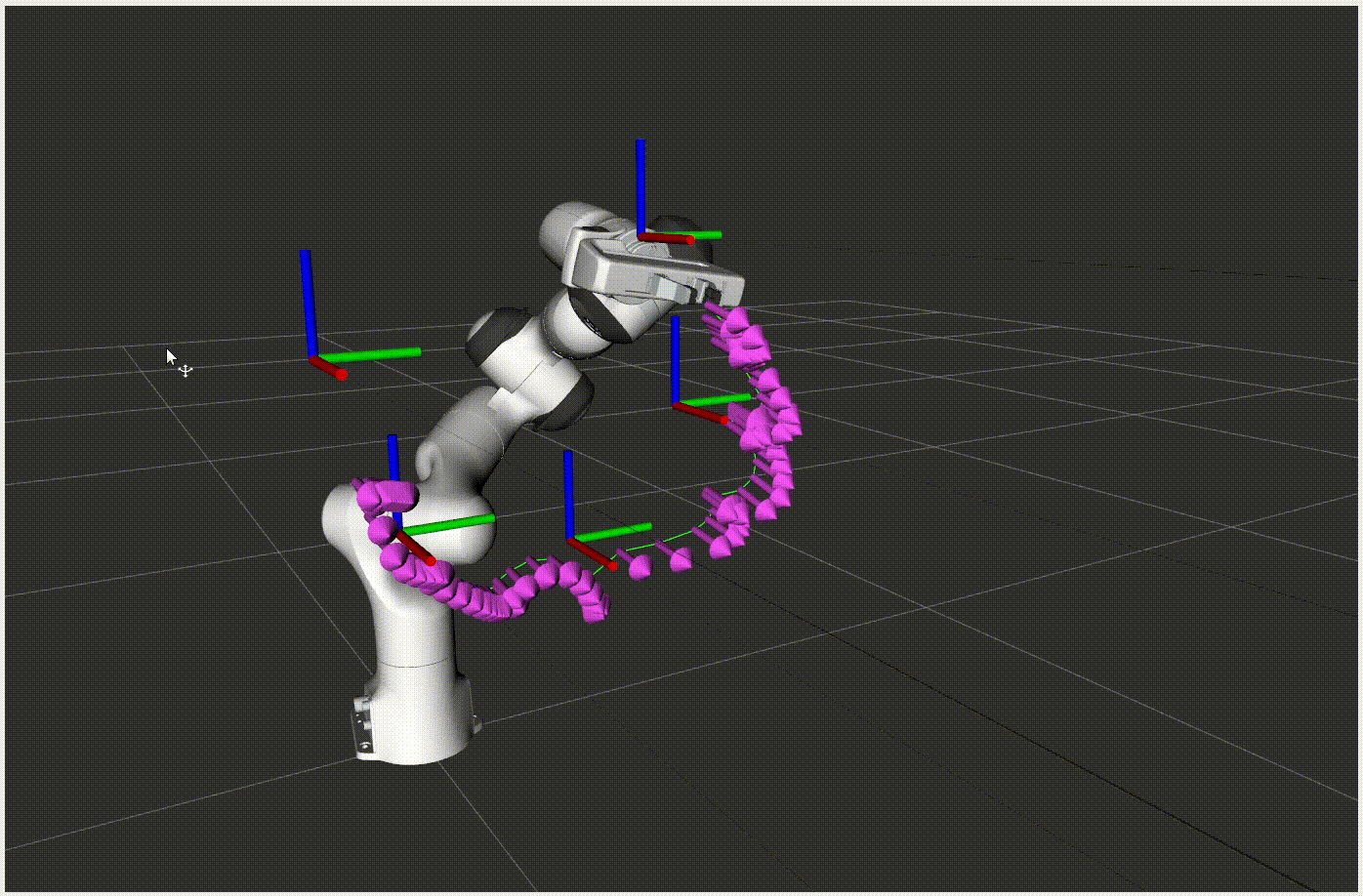This project demonstrates ROS2 functionalities for a simulation of the Panda robotic manipulator by Franka Emika. The simulation includes both a visualization of the Panda in Gazebo as well as in RViz. The control algorithm features an inverse kinematics (IK) joint trajectory planner in order to reach a desired end effector target pose. Joint group position controllers from the ROS2 controllers library are used with an effort interface to the Panda's joints in order to reach the desired joint angle targets computed from IK. Target poses for the end effector are sampled at random continuously.
First, please ensure that your system meets the basic requirements to build and run the simulation:
- Ubuntu 20.04 LTS
- ROS2 Foxy
Check out the docker directory if you want to try out this project without installing all the dependencies on your system!
$ mkdir -p ~/colcon_ws/src
$ cd ~/colcon_ws/src
$ git clone https://github.com/nicholaspalomo/panda_ros2_gazebo.git
$ cd panda_ros2_gazebo/docker
$ docker build -t panda_ros2_gazebo .
$ cd ~/colcon_ws/
$ ./src/panda_ros2_gazebo/docker/run.bash panda_ros2_gazebo build
$ ./src/panda_ros2_gazebo/docker/run.bash panda_ros2_gazebo <demo>
See below for a list of valid values to pass for the <demo> argument. Check out the entrypoint.bash to see how the demos are launched.
** At the moment, the gzclient hangs when launching the simulation from run.bash. Issue: #9 **
This project depends iDynTree library from the Italian Institute of Technology. For Debian/Ubuntu, first install the required and optional dependencies:
sudo apt-get install libeigen3-dev libxml2-dev coinor-libipopt-dev qtbase5-dev qtdeclarative5-dev qtmultimedia5-dev qml-module-qtquick2 qml-module-qtquick-window2 qml-module-qtmultimedia qml-module-qtquick-dialogs qml-module-qtquick-controls qml-module-qt-labs-folderlistmodel qml-module-qt-labs-settings
If you're not running Debian/Ubuntu on your machine, please consult the platform-specific installation instructions here.
Now, clone this repository into your colcon workspace:
$ mkdir -p ~/workspace/src
$ cd ~/workspace/src
$ git clone https://github.com/nicholaspalomo/panda_ros2_gazebo.git
Before building the project, you need to also import the repositories specified in the workspace.repos:
$ vcs import < panda_ros2_gazebo/workspace.repos
Now you can proceed to build the code:
$ cd ..
$ colcon build --merge-install --cmake-args -DIDYNTREE_USES_PYTHON=True -DIDYNTREE_USES_IPOPT:BOOL=ON -DCMAKE_BUILD_TYPE=Release
As a sidenote, I couldn't figure out how to properly use the ament environment hooks in a Python ROS2 package to append the install location of the iDynTree libraries in the colcon workspace to the PYTHONPATH environment variable. If you can figure out how to do this, other than the hacky workaround I added in panda_ros2_gazebo/panda_ros2_gazebo/examples/scripts/rbd/idyntree/__init__.py, please open a pull request and propose a solution - I'd be very grateful!
After the build process has completed, source your colcon workspace:
$ source install/setup.bash
Launch the simulation:
$ ros2 launch panda_ros2_gazebo gazebo.launch.py
This will bring up the Gazebo simulation and the RViz visualization. It will also spawn the joint controllers. Note: The robot will just be laying on the floor at the moment since the joint controllers have not actually received any setpoint yet!
To launch the node that will compute the inverse kinematics and publish the setpoints to the joint controllers, open a new terminal and navigate to the root of your colcon workspace. After sourcing your workspace, launch the node with:
$ ros2 launch panda_ros2_gazebo bringup.launch.py mode:=<demo>
where <demo> is the name of the demo you wish to run. Note that at the moment there are three demos available:
** NOTE: At the moment, the picknplace and pickninsert demos are broken. Only the follow and teleop demos are working as intended. Issue: #8 **
follow- the Panda will just follow a circular trajectory,picknplace- the Panda will pick up cubes that are spawned at random locations in its workspace and attempt to stack them one on top of the other,pickninsert- the Panda will attempt to pick up and insert spark plugs into a panel of sockets, andteleop- control the Panda with full teleoperation. See the documentation here.
After launching the teleop example, open a new terminal and source your colcon workspace.
You can launch the teleop node control the end effector (including the grippers) after launching the node with:
$ ros2 launch panda_teleop panda_teleop_control.launch.py
and following the instructions that appear in the terminal.
├── config # YAML configuration files
├── description # Panda description and world files
├── models # Robot URDFs and meshes
└── panda # Panda URDF and meshes
└── meshes # Panda meshes
├── collision # Collision meshes
└── visual # Visual meshes
└── worlds # Panda world definitions
├── launch # ROS launch scripts
├── panda_ros2_gazebo # Node definition and IK scripts
└── examples # Example nodes to run
├── scripts # IK scripts
├── model # Panda forward/inverse kinematic model
└── rbd # Rigid body dynamics utility scripts and class definitions
└── idyntree # Python interface for iDyntree bindings
└── helpers # Helper scripts for the examples
├── resource # Resource directory for ROS2
└── rviz # RViz configurationTo contribute, please make a fork of this repository and open a pull request if you would like to merge your contributions into this repository.
Nicholas Palomo, ETH Zurich (npalomo@student.ethz.ch)

